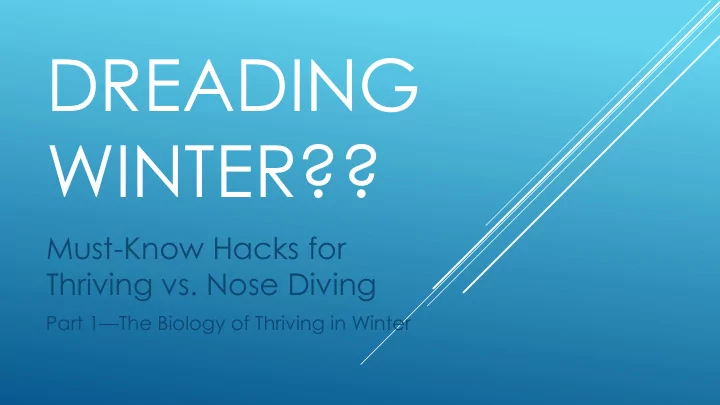

DREADING WINTER?? Must-Know Hacks for Thriving vs. Nose Diving Part 1—The Biology of Thriving in Winter
LIGHT EXPOSURE
Nature Approach: Light Box Approach: *30 min./day of bright sun *10,000 lux box exposure for depression *for most, 30 min. w/i one *15 min./day for prevention hr. of waking up *2-4 hours/day if overcast *check with doc first BRIGHT LIGHT THERAPY
Late Shift : Morning sluggishness w/ difficulty waking up on time Trouble falling asleep— stay up to exhaustion so you can fall asleep Bedtime drifts later and later Able to sleep 10 or more hours and still feel tired WHICH OF THESE 4 SLEEP PATTERNS DO YOU MOST CLOSELY FIT?
Early Shift : Fall asleep easily, but wake up way too early Unable to go back to sleep after awakening Most common pattern in clinical depression WHICH OF THESE 4 SLEEP PATTERNS DO YOU MOST CLOSELY FIT?
Fragmented sleep : Wake up frequently throughout the night No obvious time pattern to the awakenings WHICH OF THESE 4 SLEEP PATTERNS DO YOU MOST CLOSELY FIT?
Healthy sleep : Fall asleep easily Stay asleep easily Get up in the morning easily WHICH OF THESE 4 SLEEP PATTERNS DO YOU MOST CLOSELY FIT?
LATE SHIFTERS: EARLY SHIFTERS: *30 min. of bright light *30 min. of bright light exposure in exposure w/i 1 hour of wake the early evening, approx 5 hours before bedtime up at approx the same time each day *Avoid morning bright light exposure via sunglasses. *If no improvement, extend *If no improvement, shift to a to one hour or get another half-hour later for 3 days and half-hour in the late keep pushing time back 30 min. afternoon with box twice as until no longer waking up too far away early (but not within two hours of bedtime) *If needed, extend exposure time to an hour for a few weeks
FRAG SLEEPERS: HEALTHY SLEEPERS: *30 min. of bright light *15 min. of bright light exposure in the morning, ½ - 2 hours after exposure for 2 weeks ½ -1 wake up. hour after wake up at approx. the same time *If you have depression, do 30 each day. min. exposure. *If no improvement, extend *If no improvement after 2 weeks, extend exposure to 60 min. morning exposure to one hour. For all types of sleepers, once sleep quality improves, reduce duration by 5 min. per day to maintenance does of 15 min.
BRIGHT LIGHT THERAPY MAY NOT BE FOR THOSE WHO HAVE… *a serious eye disorder *Always check *extreme light sensitivity with your doctor before use! *bipolar disorder *seizure disorder *diabetes
SIDE EFFECTS: * usually… NONE! *rarely… -eye irritation -headache -mild nausea the first few times (move box further away) -serotonin syndrome -shift body clock too far (can adjust)
VITAMIN D *Hormone that on average, is at perilously low blood levels (<15mg/mL when 50-80 is optimal) in depressed patients *Over ½ the US population is deficient by end of winter *Supplementation lifts mood, sometimes even in a single megadose (10,000iu) *Fights depression via regulating gene function in the brain and other vital organ systems and also has powerful anti-inflammatory effects
Sun Exposure: Supplementation: *body converts cholesterol to *4000iu/day for up to 3 mo. Vit D with a little sun for those deficient *in US, May-Aug, 10-15 *too much can throw off *Double min/day between 11-3 (no calcium balance times if dark sunscreen; arms and face *if depressed, consider complexion exposed) 10,000iu/day with doc supervision and regular *March, Apr, Sept, & Oct, 20- 30 min/day monitoring *during Nov-Feb, supplement *elevated risk of skin cancer—DON’T SUNBURN! TWO APPROACHES
Recommend
More recommend